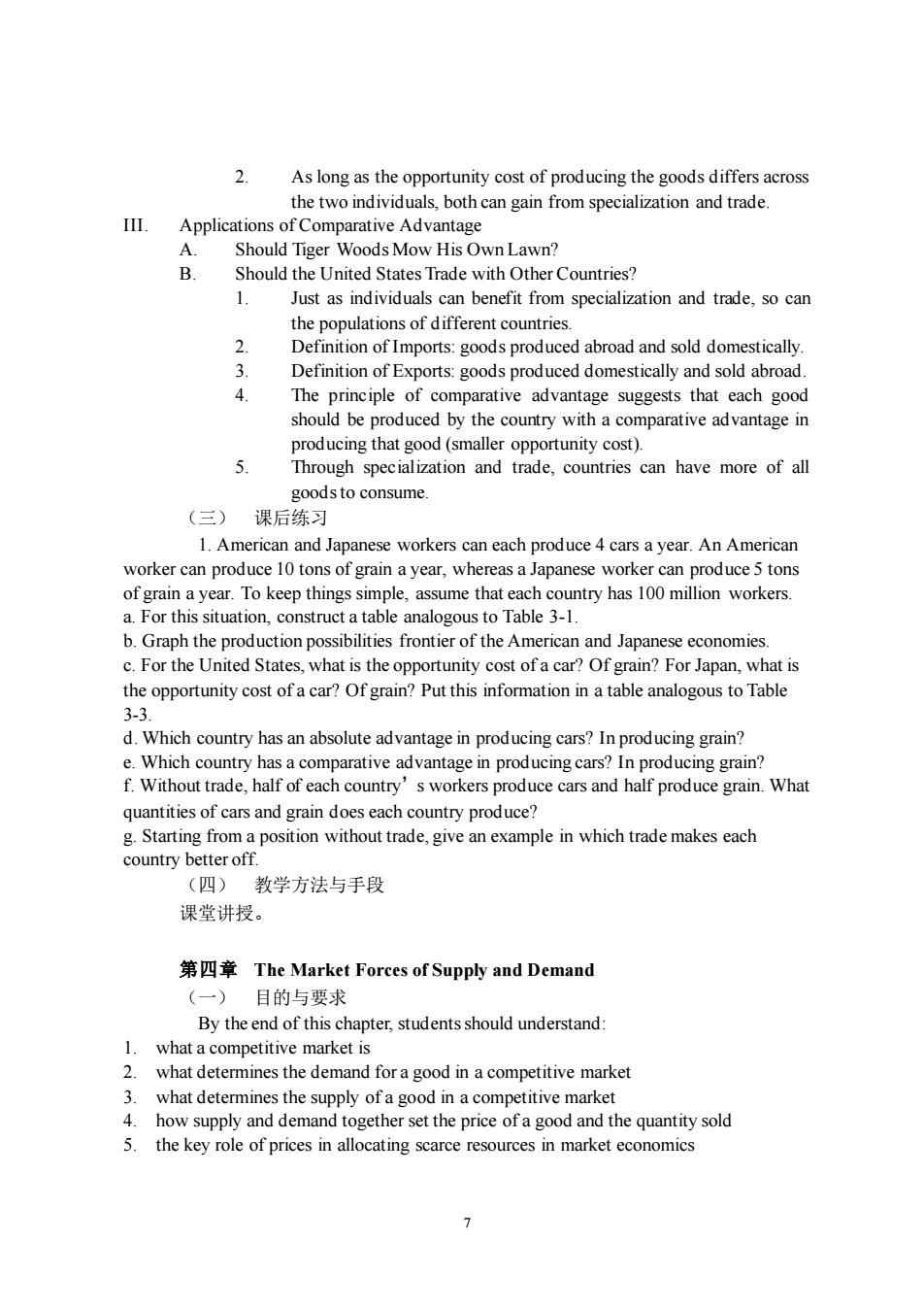正在加载图片...

2 As long as the opportunity cost of producing the goods differs across the two individuals,both can gain from specialization and trade. III.Applications of Comparative Advantage Should Tiger Woods Mow His Own Lawn? ould the United States Trade with Other Countries? Just as individuals can benefit from specialization and trade.so can the populations of different countries. 2 Definition of Imports:goods produced abroad and sold domestically. Definition of Exports goods produced domestically and sold abroad 4 The ciple of comparative advantage suggests that each good should be produced by the country with a comparative advantage in producing that good(smaller opportunity cost). Through specialization and trade,countries can have more of all oods to consume (三)课后练习 1.American and Japanese workers can each produce 4 cars a year.An American worker can produce 10 tons of grain a year,whereas a Japanese worker can produce 5 tons of grainayear.To keep thingssi ssume that eachc ountry has 100 million workers For this tuatio s to Table 3-1. b.Graph the production possibilities frontier of the American and Japanese economies c.For the United States,what is the opportunity cost ofa car?Of grain?For Japan,what is the opportunity cost of a car?Of grain?Put this information in a table analogous to Table 23 d.Which counry has an absolute advantage in producing cars?In producir ng grain? country h a comparative advantage in prod acing cars?In roducing grain? f.Without trade,half of each country's workers produce cars and half produce grain.What quantities of cars and grain does each country produce? g.Starting from a position without trade,give an example in which trade makes each ntry better off. (四) 教学方法与手段 课堂讲授。 第四章The Market Forces of Suppl y and Demand 目的与要求 By the end of this chapter.students should understand 1. what a competitive market is 2.what determines the demand for a good in a competitive market 3. what determines the supply of a good in a competitive market 4.how supply and demand together set the price of a good and the quantity sold 5.the key role of prices in allocating scarce resources in market economics 7 7 2. As long as the opportunity cost of producing the goods differs across the two individuals, both can gain from specialization and trade. III. Applications of Comparative Advantage A. Should Tiger Woods Mow His Own Lawn? B. Should the United States Trade with Other Countries? 1. Just as individuals can benefit from specialization and trade, so can the populations of different countries. 2. Definition of Imports: goods produced abroad and sold domestically. 3. Definition of Exports: goods produced domestically and sold abroad. 4. The principle of comparative advantage suggests that each good should be produced by the country with a comparative advantage in producing that good (smaller opportunity cost). 5. Through specialization and trade, countries can have more of all goods to consume. (三) 课后练习 1. American and Japanese workers can each produce 4 cars a year. An American worker can produce 10 tons of grain a year, whereas a Japanese worker can produce 5 tons of grain a year. To keep things simple, assume that each country has 100 million workers. a. For this situation, construct a table analogous to Table 3-1. b. Graph the production possibilities frontier of the American and Japanese economies. c. For the United States, what is the opportunity cost of a car? Of grain? For Japan, what is the opportunity cost of a car? Of grain? Put this information in a table analogous to Table 3-3. d. Which country has an absolute advantage in producing cars? In producing grain? e. Which country has a comparative advantage in producing cars? In producing grain? f. Without trade, half of each country’s workers produce cars and half produce grain. What quantities of cars and grain does each country produce? g. Starting from a position without trade, give an example in which trade makes each country better off. (四) 教学方法与手段 课堂讲授。 第四章 The Market Forces of Supply and Demand (一) 目的与要求 By the end of this chapter, students should understand: 1. what a competitive market is 2. what determines the demand for a good in a competitive market 3. what determines the supply of a good in a competitive market 4. how supply and demand together set the price of a good and the quantity sold 5. the key role of prices in allocating scarce resources in market economics